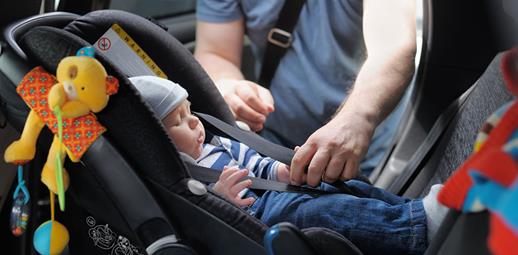
Deciding when to upgrade your child's car seat can be confusing for parents, especially given the many myths surrounding the rules.
In this guide, you’ll learn why getting it wrong could be dangerous and uncomfortable for your child, as well as unlawful. Discover the right time to change car seats and the correct type for their age, height and weight.
EASY AS HACK
Look for regulation-approved child car seats with the following labels:
- Orange label with the mandatory mark ECE R129 for height-based car seats (i-Size), plus weight and size suitability
- Orange label commonly marked ECE R44/04 for weight-based car seats, with weight suitability
- A capital E11 within a circle on both
At a glance
In a 2025 Swedish survey, 82% of 1,000 UK parents stated they knew the law about child car seats. However, 44% were unaware that a child must be over 15 months old before travelling in a forward-facing car seat. [1]
what are the different types of car seats?
Before you change car seats, it’s helpful to understand the available types.
- Rear-facing car seats
A rear-facing car seat offers the best protection for the head, neck and spine of newborns, babies and young children. Many experts believe it’s safer to keep them rear-facing, preferably on the back seat, for as long as possible. So, don’t switch car seats until they have outgrown the existing one.
Read our guide to travelling with a newborn.
- Forward-facing car seats
UK regulations permit forward-facing travel from 15 months if you have a height-based child car seat (known as i-Size).
Otherwise, if you have a weight-based car seat, your child can travel forward-facing from 9kg (about 9 months), depending on the seat group and manufacturer’s guidance.
However, many parents move their baby to a forward-facing car seat too soon. According to a Swedish survey of 1,000 UK parents, most children stop using rear-facing restraints at age 2 to 3. In Sweden, 83% of this age group are still rear facing.[1]
- High-back booster seats
A high-back booster seat provides side and head protection for older children, with a seat belt correctly positioned across your child’s shoulder and lap. According to the Swedish research, these booster seats are the most common choice for 4-7-year-olds among surveyed UK parents.[1]
Don’t confuse a high-back booster with a height-based car seat.
- Combination seats
You can also get combination seats that accommodate children of a broader age range. These can span two or more car seat groups.
You can find a list of the main groups of car seats with differing age and weight specifications below or on the GOV.UK website.
how do you know when to upgrade your child's car seat
You should decide the right time to upgrade your child’s car seat based on their weight or height, not whether they can touch the back seat with their feet (a common myth).
UK law states that children must use a car seat until they reach the age of 12 or 135cm in height, whichever comes first. At that age or height, they must then wear a seat belt.[2]
Legally, you may not move your child from a car seat until they meet the minimum requirements for the next one.
weight-based car seats
If you’re wondering when to upgrade from an infant car seat or any other, you’ll find the following useful. These are the type of weight-based car seats recommended for each group.
- Infant car seats (Group O and O+) must always be rear-facing and use a harness [2]
- Group O covers babies from birth up to 10kg or 6-9 months of age
- Group O+ seats are for babies from birth up to 13kg or around 12-15 months old
- Group 1 seats are designed for children from 9-10kg or about 9 months to 4 years old. They can be rear or forward-facing and use a harness or safety shield.
- Group 2 and 3 seats cover children weighing 15-36kg, with the former fitting those who are 4 to 6 years old and the latter catering for children of 6 to 11 years or more. They include rear and forward-facing high-backed booster seats or booster cushions, with both using a seat belt, harness or safety shield.
Groups O and O+ include baby carriers and rear-facing baby seats. You can also find lie-flat or lateral baby carriers in the Group O category.
height-based car seats
A height-based car seat or i-Size seat may be suitable when you’re considering when to change your child’s car seat.
It typically fits into a car’s ISOFIX points (a system where the child seat plugs into a point on the adult seat) or uses a seatbelt.[3] Safety experts RoSPA say these seats provide enhanced side-impact protection and ensure your child stays facing the rear for longer.[4]
An i-Size seat should be rear-facing from birth until your baby is 15 months old and 76cm. It’s safer to leave them rear-facing for longer if possible.
Which? [5] offers the following height-based car seat guidelines:
- Baby to toddler (0 months to 4 years): 40cm-105cm
- Toddler to child (12 months to 4 years): 61cm-105cm
- Baby to child (0 months to 12 years): 40cm-150cm
- Child (4 years to 12 years): 100cm-12 years
when should you replace your child's car seat?
In addition to upgrading your child’s car seat, you might be wondering when to replace it.
Start by looking at the manufacturer’s guidelines. They typically recommend replacing a child’s car seat every five years, which is a wise move anyway, as wear and tear is inevitable.
You should always replace a child’s car seat if it’s involved in a road traffic accident.
car seat expired
Unlike medicines, there is no legal expiry date on children’s car seats. Instead, each manufacturer will provide a service life or best-before date based on its tests. The date is typically from 5 to 10 years.
Make a note of the manufacturing date and best before/service life, so you’ll know when to replace the car seat. The label is usually on the car seat.
car seat damaged
Damage from a road traffic accident may not be visible on a car seat. So, it’s best to avoid using a car seat that’s been in a crash. It might also be risky to buy a second-hand seat, as you won’t know whether it was in an accident.[6] Parts could also be missing.
Other ways a car seat can get damaged include general wear and tear from the messes your little one makes or being in the sun for too long.
changing cars
If you’re changing cars, it’s likely to have ISOFIX fittings if it was manufactured in 2007 or later. Most are compatible with i-Size seats, but it’s best to confirm whether it fits beforehand, as not all of them will fit.
- Check a list of approved vehicles that fit the seat to see if your car seat is suitable.
- Otherwise, you could compromise the safety benefits of an i-Size seat if it doesn’t fit properly, is unstable or incorrectly installed.
In future, the government will only allow height-based i-Size seats in the UK. For now, most child car seats are grouped according to a child’s weight. So, if you already have a weight-based seat, you don’t need to swap it for an i-Size one when changing cars, unless you want to.
Remember that not all weight-based cars are universally compatible either. Many rely on ISOFIX or appropriate seatbelts. The car seat could be unsafe if you don’t ensure it fits correctly when changing cars.
when can a child stop using a car seat?
Children must use the correct car seat:
- Until they are either 12 years old or have reached 135cm in height – whichever is first
- After this, they must wear a seat belt if they are 12 or 13 years old, or younger and over 135cm. They’ll no longer need a car seat.
As a driver, it’s your responsibility to ensure a child under 14 has proper restraints, whether it’s by using a car seat or a seat belt. You could face a fine of up to £500 if you do not comply. [2]
car seat safety guidelines & requirements
You should choose a baby and child car seat regulated under two EU-approved rules: European safety regulation ECE R129 or one that meets the older ECE R44 standard, which R129 will eventually replace.
- The i-Size seat comes under R129. The approved labels to look out for on an i-Size seat are R129 with E11 in a circle
- All car seats will eventually need to meet the tighter standards required for height-based seats
- If you have a weight-based seat, ECE R44 applies. It should have an R44 label, also with an encircled capital E11, beside the letters ECE R44.[2]
Using the correct car seat for your child’s age and size isn’t just a safety must – it’s a legal requirement. Visit GOV.UK for more on seat belts and the law.
insurance guidelines
As well as fines for failure to comply, you could lose out on an insurance claim if you are in an accident. An insurer may consider your actions contributed to the cause of an accident and reduce any compensation for injury if you or a passenger is not wearing an appropriate restraint.
You must inform your insurance company if your child is exempt from using a car seat or seat belt for medical reasons.[2] A valid medical exemption certificate from a doctor will show your insurer that you are compliant. You should always have it when travelling, so you can show it to the police.
Stay updated with car seat guidelines to help ensure your cover remains valid and your family stays protected.
Learn how Ageas car insurance protects your family.
FAQs
do you need to upgrade your child's seat to an i-size seat?
You don’t have to upgrade your child seat to an i-Size seat just yet – unless you want to.
In the future, the UK will only permit height-based i-Size car seats, but the government has yet to set a specific date. For now, the guidance categorises most child car seats by the child’s weight.
how long should you keep your child in a rear-facing child seat?
You should keep your child in a rear-facing child seat until they are:
- At least 15 months old
- However, if you can keep your child rear-facing for longer than that, then do so, as it will mean their head, neck and spine are better protected.
Sources
[1] www.axkid.com
[2] www.gov.uk
[5] www.which.co.uk
